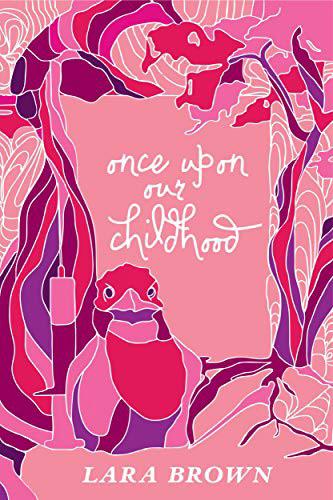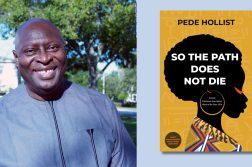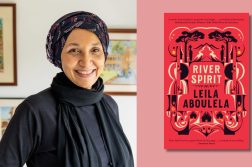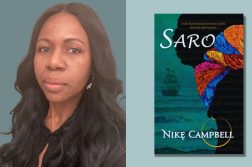Book: Once Upon Our Childhood
Author: Lara Brown
Lara Brown’s debut novel Once Upon Our Childhood is a coming-of-age story of four teenage girls, the dynamics of their friendship and the events that shaped their experiences. The novel, a teen/young-adult realist fiction, explores a variety of themes— love, grief, mental illness, suicide, gender-based violence, and a host of others— while staying true to the young but vibrant voices of the story’s narrators.
Each chapter is one of the characters telling her version of the story in a highly distinct manner, not failing to highlight her quirks and intimacies, while exploring the larger narrative thread along with the reader. The characters are each dissimilar yet held delicately by the bond of their friendship, the nuances of how each felt their collective experience, and the attention given to every one of them by the author. True to the realist fashion, it is difficult to pinpoint the narrative to a singular object of interest. This is because the story, like life, is not about any singular object of interest. Except, perhaps the narrative function itself— the recreation and reframing of experience.

Brown gives us insight into the beginnings of her book, saying the first draft was written when she was only fourteen years of age. Of course, it is easy to see the amount of work that must have gone into the story— restructuring, reimagining, repossessing— to make it the highly intricate, deeply personal piece of narrative that it has turned out to be. However, you will still find the fourteen-year-old author in the language of the characters and ambiance of the work.
One steps a curious foot into the novel but is immediately swept up by the strong currents of the plot. The prologue, very rich in symbolism— two-faced monsters, kookaburras, tree, blood, and a razor— provides a certain form of shock value. This perhaps results in the shedding of all preconceived assumptions. The presence of “childhood” in the title and the radiant pink book cover does nothing to prepare one for the self-harm that is encountered only a few pages into the book, but then, as they say, one shouldn’t judge a book by its cover— especially when it’s pretty in pink.
Lara. Fola. Bibs. Abi.
After the prologue, the mood relaxes tangibly, and the reader is introduced almost jovially, to the four protagonists, each in her corresponding chapter.
Lara appears to the reader as a character with a grudge. She is snarky in her speech, but also quite sensitive; and quite adept in the art of self-recrimination:
…for all my many perceived flaws—She lies! She smokes! She drinks! She dresses like that renowned streetwalker in her heydays! She never listens!—I am not a braggart.
But her quick tongue, as it turns out, is not limited to listing her flaws alone. The earlier mentioned grudge seems to be directed at the world in its entirety— the hell hole of a country where she resides, her liar of a mother (who is also completely unskilled as far as mothering is concerned), her father who has miraculously resurrected from the dead, and even her brothers who seem to have materialized from nowhere. As the first narrator, it is through Lara’s descriptions that we catch the initial glimpse of the rest of the group. And despite the sarcasm evident in her tone, and the witticisms sprinkled in her speech, Fola, Bibs, and Abi are efficiently recreated in our minds, bit by bit.
Fola. The introduction to Fola’s life is an introduction to luxury. Monogrammed towels, power suits, Lexus SUVs. It is also an introduction to an easily disguised dysfunctional family. Upon meeting Fola, one realizes that Lara’s description of her — Miss ‘Daddy-is-a-bloody-rich-telecommunications-mogul’— is correct to the letter. She is condescending in her manner, and apparently insensitive. Early in the story, the reader witnesses Fola in a spar of words with a classmate, and the verbal attack she launches is one of a teenager with a very long leash, and too much pocket money:
And clearly, you’re yet to realize that you will never be fortunate enough to be a part of the smarter and more privileged minority.
…Hey, don’t blame me because your father can hardly afford to pay school fees for you and— what was the number at the last count—fifteen siblings? Girl, bye!
Despite all these, Fola is able to form a genuine bond with the rest of the group, especially Lara.
Abi, the daughter of a struggling single mother and a runaway father bears the portraiture of naiveté. She, unlike the rest of the group, is unused to luxury. Her voice is the not-exactly-peculiar one of a middle-class Nigerian. She also seems to have a penchant for getting into trouble, but like the others, finds solace in the little group.
Bibs. Upon introduction by Lara, Bibs seems to be the most delicate of the lot. The Lara character even admits to having a soft spot for the eighteen-year-old product of a polygamous family, a violent father is in the picture. Bibs’ voice is one that seems to have survived several attempts at suppression. She is calm and thoughtful but also apparently secretive, and this sets her apart from the rest of the group. The other friends hardly succeed in unraveling her, with the exception of Lara who once catches a glimpse of her vulnerability, and to whom she is closest.
Lara with all her flaws seems to have a firmer understanding of the friends than they sometimes even have of themselves, and one suspects that she is a kind of authorial figure surreptitiously inserted into the text. This is not even difficult to imagine considering that the character shares a first name with the author of the novel, Lara Brown!
As the plot thickens, each of the girls is given an opportunity to see themselves as they truly are. They all become victims of another’s sometimes predatory passions, all inevitably suffering varying degrees of pain — some too heavy to bear. This character development thread is necessary for the individual narratives but threatens to split their relationship with one other to shreds.
Brown expertly exposes and navigates the multiplicity of the traumas and singlehandedly pushes the narrative forward at the same time. Although the narrative follows a typical “man in hole” plot arc, Brown infuses into the merely popular, a dash of artistic intention. The novel is split into three parts, with each part signifying a distinct phase in the narrative arc, and labeled by a line or two of a popular nursery rhyme.
The first part, which is the phase of general goodwill, and seeming normality, is annotated, Ring a ring o’ roses, a pocket full of posies. The next part, where the tension which had been building up from the beginning becomes perceptible, is labeled A-tishoo! A-tishoo! We all fall down, the third part, clearly signifies the general mayhem that eventually ensued.
The text is also followed by an epilogue that underlines the socio-political undertones that had became more and more visible as the story progressed. Brown seems to have used the narrative of her debut novel to push an agenda of highlighting socio-political issues like sexual assault, abortion, drug use, amongst others. The reader also notices a mental health sensitization going on between the lines of the narrative. In the epilogue of the novel, this agenda cannot be clearer, as the author literally includes a sensitization seminar scene as an accompaniment to the bulk of the story.
One also senses a determined authorial interest in happy endings, even if it serves as an attempt to conceal fatality.
Lara Brown’s novel proved to be deeply engaging. The reader appreciates the precision of the multiple voices, and the author’s ability to navigate the personas of the four protagonists with such ease of execution— switching easily between tenses, and narratives. Once Upon Our Childhood is a worthy read.
The review copy of Once Upon Our Childhood was given to us by The BookLady NG
Once Upon Our Childhood is available on RovingHeights here
Ese Emmanuel is currently a final year student of a Nigerian university. She has an overwhelming love for books and humorously refers to reading as ‘the one true love of her life’. She believes herself to be revolutionary and can be reached via Twitter and Instagram, @_eseemmanuel.


